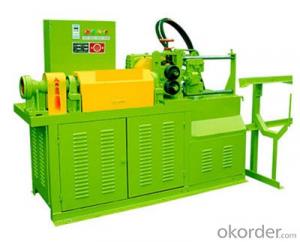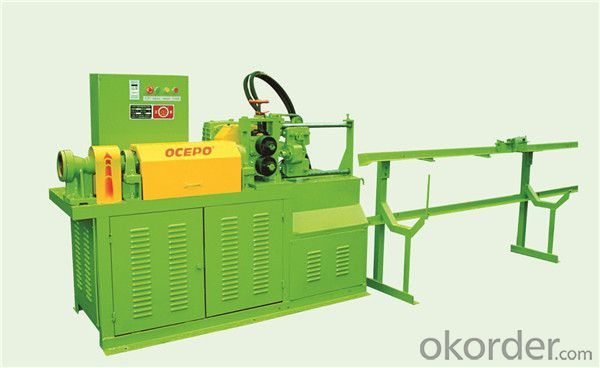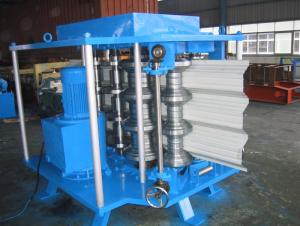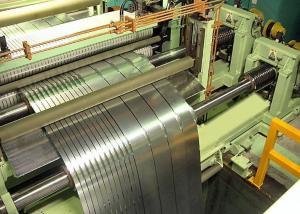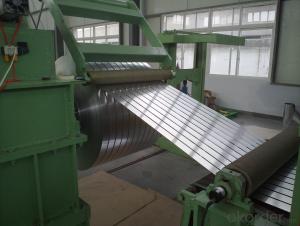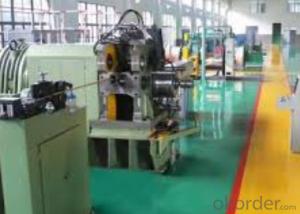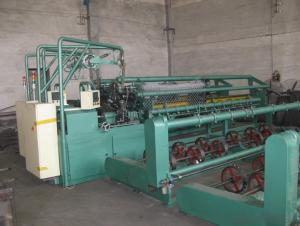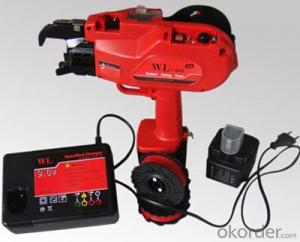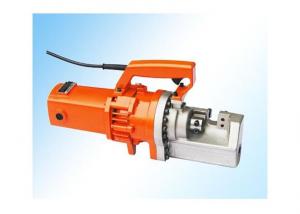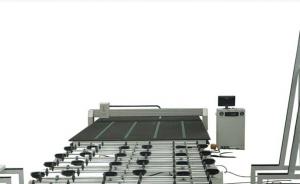Hydraulic Rebar Straightening and Cutting Machine YGT6-12
- Loading Port:
- Tianjin
- Payment Terms:
- TT OR LC
- Min Order Qty:
- 1 unit
- Supply Capability:
- 200 unit/month
OKorder Service Pledge
OKorder Financial Service
You Might Also Like
Hydraulic Rebar Straightening and Cutting Machine YGT6-12
Specification
Straightening Round Bar Dia.
Φ4-Φ12mm
Auto Cutting Length
700-8000mm
Error of Auto Cutting Length
±10mm
Straightening Speed
45m/min
Electromotor for Straightening
Model
Y132S-4
Rated power
5.5Kw
Electromotor for Cutting
Model
Y100L2-4
Rated Power
3.0Kw
Electromotor for pulling
Model
Y100L2-4
Rated Power
3.0Kw
Dimension
1900*600*1400mm
Application
The machine is used to straighten and cut round bar (steel rod).
Advantage
1. Smart size and space saving
2. Easy to operate, with fast speed
3. Low material loss
4. Economic
5. Hydraulic cutting, have low noise
Packing
Plywood Case
Payment
T/T L/C
Delivery
Within one week
Origin
China
Minimum Order
1 set
Packaging
Plywood case
Remarks
OEM & ODM, Buyer Label can be provided.
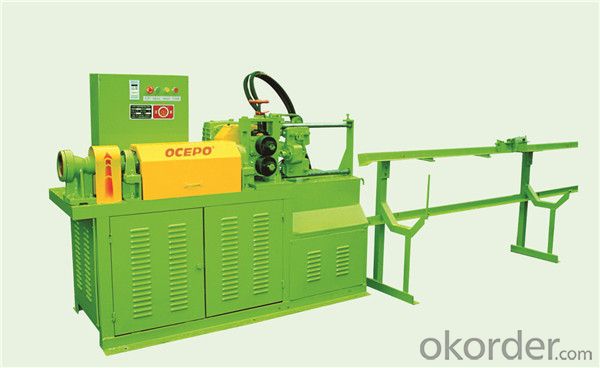
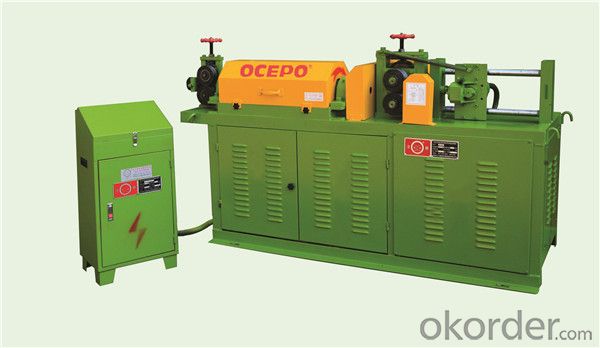
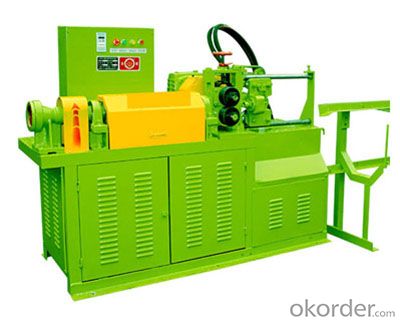
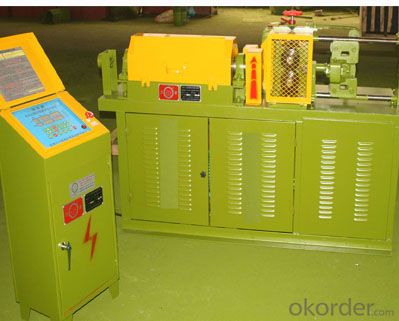
Company Direction
We are China professional manufacturer and system solutions provider of rebar connection machines,rebar processing machines and small road machines.
Founded in the 1990s. For 20 years, it has been focusing on the research, production and sales of rebar connection machines and rebar processing machines. The company is located in the capital of China - Beijing, has strong technical force, complete processing equipment and testing means. All the products are optimized by microcomputer design to reach the advanced level of industry.
- Q: How does metal straightening machinery handle the straightening of metal components with residual stresses?
- Metal straightening machinery handles the straightening of metal components with residual stresses by utilizing controlled forces to gradually bend and reshape the material. The machinery applies pressure to the areas of the component that have residual stresses, gradually increasing the force until the metal yields and the stresses are relieved. This process helps to restore the component to its original shape and eliminates any deformations caused by residual stresses.
- Q: Does the machinery produce any noise or vibrations during operation?
- Yes, the machinery does produce noise and vibrations during operation. The level of noise and vibrations generated can vary depending on the type and size of the machinery. Some machinery, such as heavy-duty industrial equipment, can produce loud and significant vibrations that can be felt and heard from a distance. On the other hand, smaller machinery like household appliances may produce less noticeable noise and vibrations. It is important to consider these factors when using machinery in order to ensure proper safety precautions are taken, such as wearing hearing protection and securing the machinery on stable surfaces to minimize vibrations.
- Q: Does this machinery have any built-in features for detecting and correcting material twisting?
- Indeed, this machinery boasts remarkable built-in capabilities for identifying and rectifying material twisting. Among these capabilities are sensors adept at detecting any twisting of the material, prompting the machinery to autonomously modify its settings to resolve the issue. Moreover, the machinery incorporates mechanisms capable of physically realigning the material as it progresses through, guaranteeing its sustained straightness and absence of twisting. Evidently, these integrated attributes greatly augment the production process's overall quality and efficiency.
- Q: Is it possible to straighten metal without using this machinery?
- Yes, it is possible to straighten metal without using machinery. This can be done by applying manual force, using tools like hammers or vices, or by employing heat and cold techniques such as heating and cooling the metal to manipulate its shape.
- Q: Does this machinery have any built-in data logging or reporting capabilities?
- Yes, this machinery is equipped with built-in data logging and reporting capabilities.
- Q: Can metal straightening machinery be used for straightening food or beverage processing components?
- Metal straightening machinery is designed specifically for the purpose of straightening metal components such as pipes, rods, or sheets. It makes use of high pressure or heat in order to reshape and straighten metal materials. In contrast, food or beverage processing components are typically made from different materials such as plastic, glass, or stainless steel. These components require specialized equipment and techniques in order to straighten or repair any damages. Furthermore, food and beverage processing components are subject to specific regulations and standards aimed at ensuring hygiene and safety, which may not be applicable to metal straightening machinery. Therefore, it is not advisable to employ metal straightening machinery for the purpose of straightening food or beverage processing components.
- Q: What is the level of speed and efficiency of this machinery?
- The machinery's speed and efficiency are truly remarkable. It is constructed using state-of-the-art technology, enabling it to operate at high speeds without compromising efficiency. Its advanced features and precise engineering allow for swift and accurate task execution, resulting in heightened productivity and less downtime. Moreover, the machinery integrates innovative systems that reduce energy consumption and waste generation, further enhancing its efficiency. In summary, this machinery's speed and efficiency are unparalleled, making it an invaluable asset in industrial or commercial environments.
- Q: Can this machinery be used for straightening metal with specific material strengths?
- Yes, this machinery can be used for straightening metal with specific material strengths. This machinery is designed to apply controlled force and pressure to metal materials, allowing them to be bent or straightened as needed. The specific material strengths of the metal can be taken into account and adjustments can be made to ensure that the straightening process is done effectively without causing any damage to the metal. The machinery is equipped with various tools and features that enable it to handle different types of metal with varying strengths, making it suitable for straightening metal with specific material strengths.
- Q: How does metal straightening machinery handle surface imperfections or defects?
- Metal straightening machinery is designed to handle surface imperfections or defects in a highly efficient and effective manner. These machines utilize various techniques and mechanisms to ensure that the metal surfaces are corrected and brought back to their desired shape and smoothness. One common technique used by metal straightening machinery is the application of pressure. The machine exerts controlled and directed force on the metal surface, allowing it to reshape and realign. This pressure helps to correct any bends, twists, or warps that may be present due to surface imperfections or defects. In addition to pressure, metal straightening machinery may also employ heat as a means to handle surface imperfections. By heating the metal, it becomes more malleable and easier to manipulate. The heat can help to soften the surface imperfections and make it easier to straighten and correct any defects that are present. Another technique used by metal straightening machinery is the use of rollers or dies. These machines have specially designed rollers or dies that apply pressure to the metal surface in a controlled manner. As the metal passes through these rollers or dies, it is straightened and any surface imperfections or defects are smoothed out. Furthermore, some metal straightening machinery may utilize laser technology to handle surface imperfections or defects. Laser straightening involves the use of a high-powered laser beam that is directed onto the metal surface. The heat generated by the laser causes the metal to expand, allowing for the correction of any imperfections or defects. Overall, metal straightening machinery is highly effective in handling surface imperfections or defects. Whether through the application of pressure, heat, rollers/dies, or laser technology, these machines ensure that metal surfaces are straightened and brought back to their desired shape and smoothness.
- Q: Can metal straightening machinery be integrated into a larger production line?
- Yes, metal straightening machinery can be integrated into a larger production line. Integration allows for seamless and efficient processing of metal components, ensuring a smooth transition between different stages of production. By incorporating metal straightening machinery into a larger production line, manufacturers can improve productivity, reduce downtime, and achieve consistent, high-quality results.
Send your message to us
Hydraulic Rebar Straightening and Cutting Machine YGT6-12
- Loading Port:
- Tianjin
- Payment Terms:
- TT OR LC
- Min Order Qty:
- 1 unit
- Supply Capability:
- 200 unit/month
OKorder Service Pledge
OKorder Financial Service
Similar products
Hot Searches
